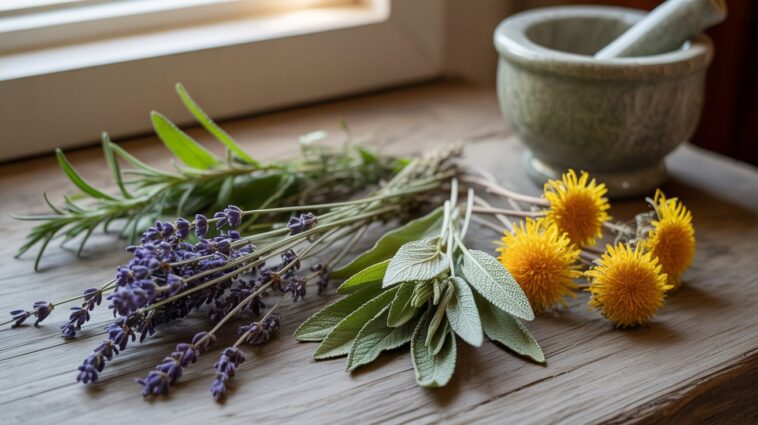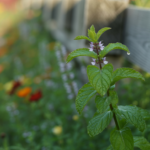When I first started gardening, my focus was mostly on vegetables and a few kitchen herbs. But over time, I got curious about how people used to grow their own medicine right alongside their food. That’s when I dipped into the world of medicinal herbs—and honestly, it changed the way I garden.
Having a living medicine cabinet right outside my door has been such a gift. These herbs not only support my well-being, but they also attract pollinators, add beauty to my garden, and fill the air with amazing scents. Whether I’m brewing tea, making a soothing balm, or just admiring the way the plants sway in the breeze, these herbs are now essential to my space.
Here are 12 of the best medicinal herbs I grow in my yard—ones that are easy to care for, powerful in use, and a joy to harvest.
Chamomile
I started growing chamomile for tea, but I quickly fell in love with everything about it. The tiny daisy-like flowers bloom profusely, and the scent is sweet and calming. I grow German chamomile, which is an annual, and I harvest the flowers throughout summer to dry for tea. It’s known for its ability to soothe anxiety, ease digestion, and help with sleep. Bonus: bees absolutely adore it.
Lemon Balm
Lemon balm was one of the first medicinal herbs I grew, and I’ve never looked back. This mint family member is super easy to grow and spreads quickly (so I keep it in a large pot). I use the lemony leaves in teas, syrups, and even tinctures. It’s a powerful mood-lifter and calming herb, great for stress relief and insomnia. Fresh leaves straight from the garden always feel like a little boost of sunshine.
Peppermint
Mint is a classic medicinal herb, and peppermint is one I always have on hand. It’s a digestive powerhouse—perfect for relieving nausea, bloating, and headaches. I make teas, add it to foot soaks, and infuse oil for salves. It grows vigorously, so I keep it in containers, but that makes it easy to move around as needed.
Calendula
If I had to choose one herb that embodies the healing power of plants, it would be calendula. The bright orange and yellow petals are packed with skin-soothing properties. I grow it in raised beds, harvest the flowers, and dry them to make healing salves, oils, and creams. Calendula is excellent for cuts, burns, rashes, and more. It’s also beautiful, making my garden glow in the summer sun.
Echinacea
Also known as coneflower, echinacea is not only stunning, but it’s also one of the best immune-boosting herbs you can grow. I plant it in full sun, and the purple blooms draw in bees and butterflies all summer long. I harvest the roots and flowers to make tinctures that help fend off colds and shorten the duration of illness. It’s a perennial, so it comes back stronger each year.
Yarrow
I stumbled upon yarrow growing wild in a meadow years ago and immediately fell for its ferny foliage and umbrella-like flowers. It’s incredibly useful medicinally: it helps stop bleeding, reduces fevers, and supports wound healing. I grow white and pink varieties along my fence line, and the plants are drought-tolerant and easy to care for. I dry the leaves and flowers for tea and poultices.
Holy Basil (Tulsi)
Holy basil, or tulsi, is considered sacred in Ayurveda—and after growing it for several seasons, I understand why. The scent is spicy and uplifting, and the leaves make an incredible adaptogenic tea. I grow it in a sunny spot and harvest regularly to keep it bushy. It’s known for helping the body adapt to stress, supporting the immune system, and promoting clarity and calm.
Lavender
Lavender might be best known for its scent, but it’s also a potent healing herb. I use the buds in teas, sachets, bath salts, and sleep pillows. It has calming, antiseptic, and anti-inflammatory properties. I grow English lavender, which thrives in dry, sunny spots with good drainage. The bees love it, and I love brushing past it and catching that relaxing fragrance.
Sage
Sage is another herb with both culinary and medicinal value. I grow common garden sage in a dry, sunny corner, and it just keeps coming back year after year. Medicinally, it’s used for sore throats, coughs, and menopause symptoms. I make a simple sage tea whenever I feel a tickle in my throat, and it works wonders.
Thyme
This tiny-leaved herb might not look like much, but it packs a punch medicinally. Thyme is antimicrobial, making it great for colds, coughs, and respiratory infections. I harvest the sprigs, dry them, and use them in steam inhalations and teas. It’s also a hardy perennial that grows low and spreads gently, perfect for filling in between stones or edging garden beds.
Valerian
Valerian is a taller plant with delicate white flowers and a deep earthy smell in the roots. I grow it in a semi-shaded area where it gets morning sun. It’s best known as a sleep aid, and I dig the roots in the fall to dry and use in teas and tinctures. The leaves and flowers attract beneficial insects too, so it’s a lovely addition to any backyard apothecary.
Rosemary
Rosemary is uplifting, warming, and antimicrobial. I grow it in pots since my winters can be a bit too harsh, and I bring it indoors when the cold hits. I use the sprigs in teas for circulation, memory support, and immune health. Just rubbing the leaves between your fingers releases a scent that instantly energizes me.
Growing medicinal herbs has brought a whole new layer of purpose and joy to my garden. It feels incredibly empowering to walk outside, pick a few leaves or flowers, and brew up something that helps me feel better—naturally. And the best part? These plants are beautiful and beneficial in equal measure.
If you’re just starting out, pick one or two herbs that speak to you. Start small, get to know their growing habits and healing powers, and watch your backyard medicine garden blossom.
Would you like a garden layout showing how to group these herbs together based on sun and water needs? I can create a visual for that!

